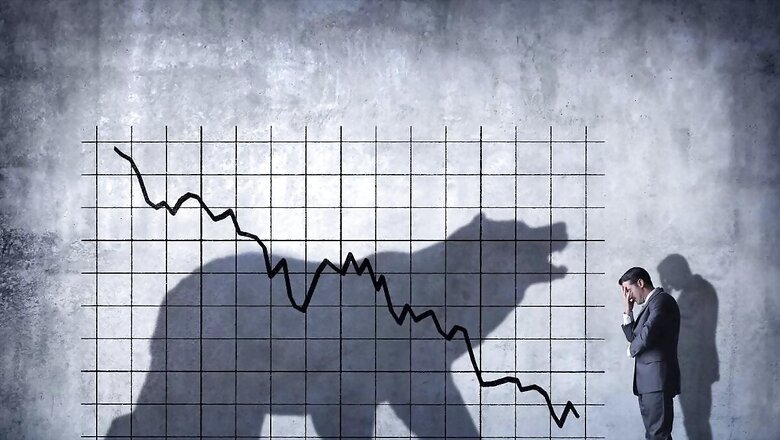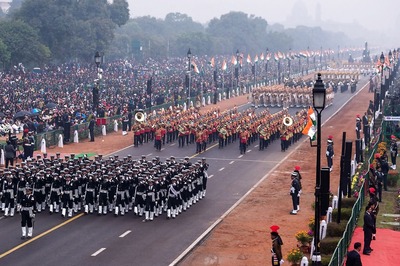
views
The domestic equity markets on Monday started the week with a steep decline breaking Budget Day low levels amid sell-off across the globe due to weak US jobs reports hinting towards a US recession. In the global markets, all major markets were in the red as much as 11 per cent. Japan’s Nikkei was trading down by 9.87 per cent and Tokyo’s Topix Index was down as much as 10.6 per cent.
In the US, Dow Jones fell 1.51 per cent in its latest session, while Nasdaq was also down by 1.84 per cent. In Europe, London-based FTSE fell 1.31 per cent.
The NSE Nifty fell by over 700 points to below the Budget Day low 23,074 on July 23, while the the BSE Sensex was trading down by about 2,600 points at 78,423. However, till the end of the day, the domestic markets recovered some losses.
The BSE Sensex on Monday ended the day 2,222 points lower or 2.74 per cent to close at 78,759.40, while the NSE Nifty closed down by 662 points or 2.68 per cent at 24,055.
However, pharma and FMCG stocks in India performed well despite the bloodbath in the markets across the globe.
“Indian markets have been affected due to global factors. Investors should wait and watch now. Not all days are for profits. The Indian markets are resilient. If at all investors are to put some stocks for watch, pharma and FMCG look good as of now. Investors should completely avoid global-dependent shares,” according to a market expert.
Why Are Markets Falling Across the Globe?
1) Interest rate hike in Japan last week by 0.25 per cent increased risk of cuts in yen carry trades.
2) The US labour market cooled more than expected in July. Employers added 1,14,000 jobs, below expectations for an increase of 175,000. The unemployment rate rose to 4.3 per cent, above economists expectations that it would be unchanged on the month at 4.1 per cent. Traders are now pricing in a 71% probability that the Fed will cut rates by 50 basis points in September, up from 31% before the data was released and from 22% on Thursday, according to the CME Group’s FedWatch Tool.
The US interest rates movements depend on two things — inflation and jobs.
3) There is a risk of escalation in the Israel-Iran conflict after the assassination of Hamas political head Ismail Haniyeh.
V K Vijayakumar, chief investment strategist at Geojit Financial Services, said, “Recently, the rally in the global stock markets has been driven mainly by consensus expectations of a soft landing for the US economy. This expectation is now under threat with the fall in US job creation in July and the sharp rise in US unemployment rate to 4.3%. Geopolitical tensions in the Middle East also are a contributing factor. Another significant factor is the unwinding of the Yen carry trade which is bleeding the Japanese market. The crash in Nikkei by above 12% this morning is an indicator of the crisis in the Japanese market.”
Valuations in India, driven mainly by sustained liquidity flows, continue to be high particularly in the mid and smallcaps segments. The overvalued segments of the market like Defence and Railways are likely to come under pressure. The buy on dips strategy which has worked well in this bull run, is likely to be threatened now. Investors need not rush to buy in this correction. Wait for the market to stabilise, he added.
Tanvi Kanchan, head (UAE Business & Strategy) at Anand Rathi Shares and Stock Brokers, said, “Broader indices traded at a negative zone, emulating the global indices after the Nasdaq and the S&P lost 3.2% in 2 trading days, post the federal reserve decided to hold interest rates. Asian stocks stumbled on the backs of US economic slowdown, an extended route in Japanese stock markets and rising tension in the Middle East.”
On Monday, several regional equity indexes faced significant declines, with Japan and the tech-focused markets of Taiwan and Korea experiencing the heaviest losses, each seeing their benchmarks drop by more than 7%. The MSCI Asia Pacific Index fell by as much as 4.3%, heading towards a technical correction and threatening to wipe out all its gains for the year.
“This sell off is more of a short-term volatility by way of profit booking and is no indicator of any long term panic mode set in the Indian equities. For investors looking at entering the equity market, a staggered entry during volatile periods can be considered,” Kanchan.
Technical Analysis
Vishnu Kant Upadhyay, AVP, research and advisory at Master Capital Services, said, “Additionally, the yen carry trade has further dampened global sentiment. However, given the prevailing bullish trend, it is unlikely that prices will remain low for an extended period. A recovery from these lower levels is a probable scenario. Every market decline should be viewed as an opportunity to establish new long positions for long-term holding. The Nifty50 has major support in the 24,200-24,100 range, and prices are unlikely to fall below this zone, while the Sensex has significant support around 78,400, near the 55-day EMA.”



















Comments
0 comment